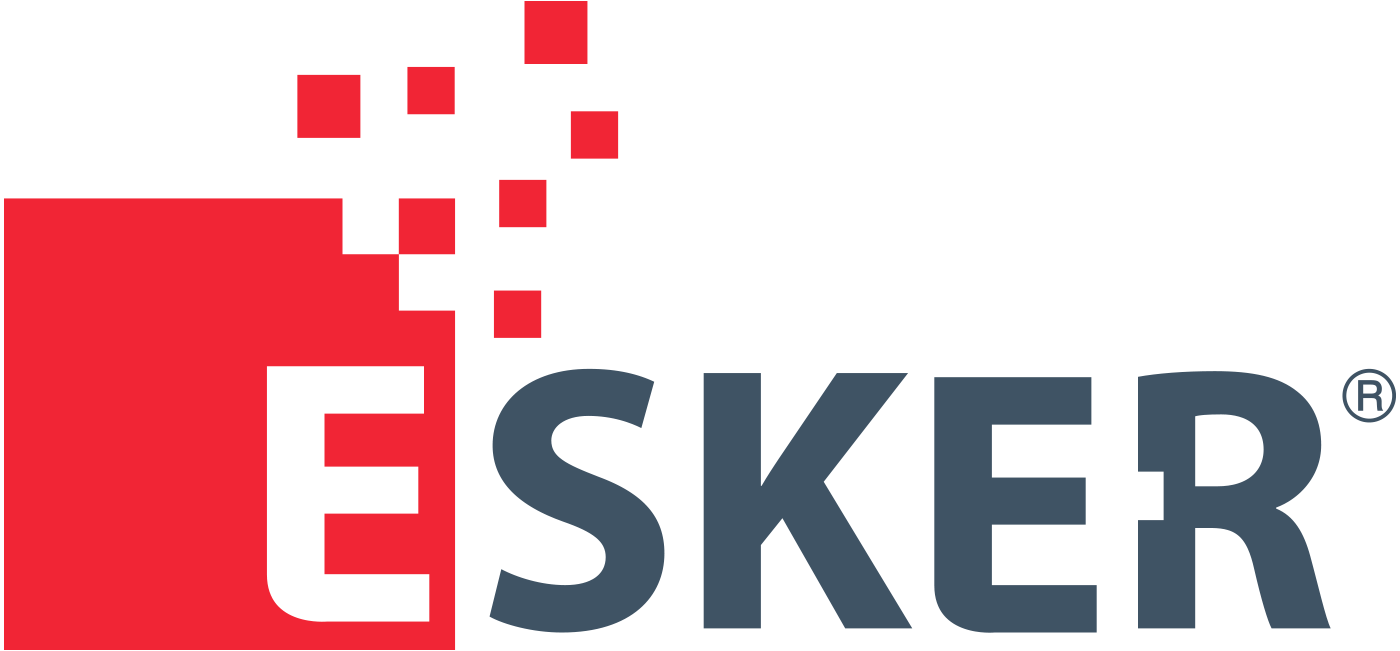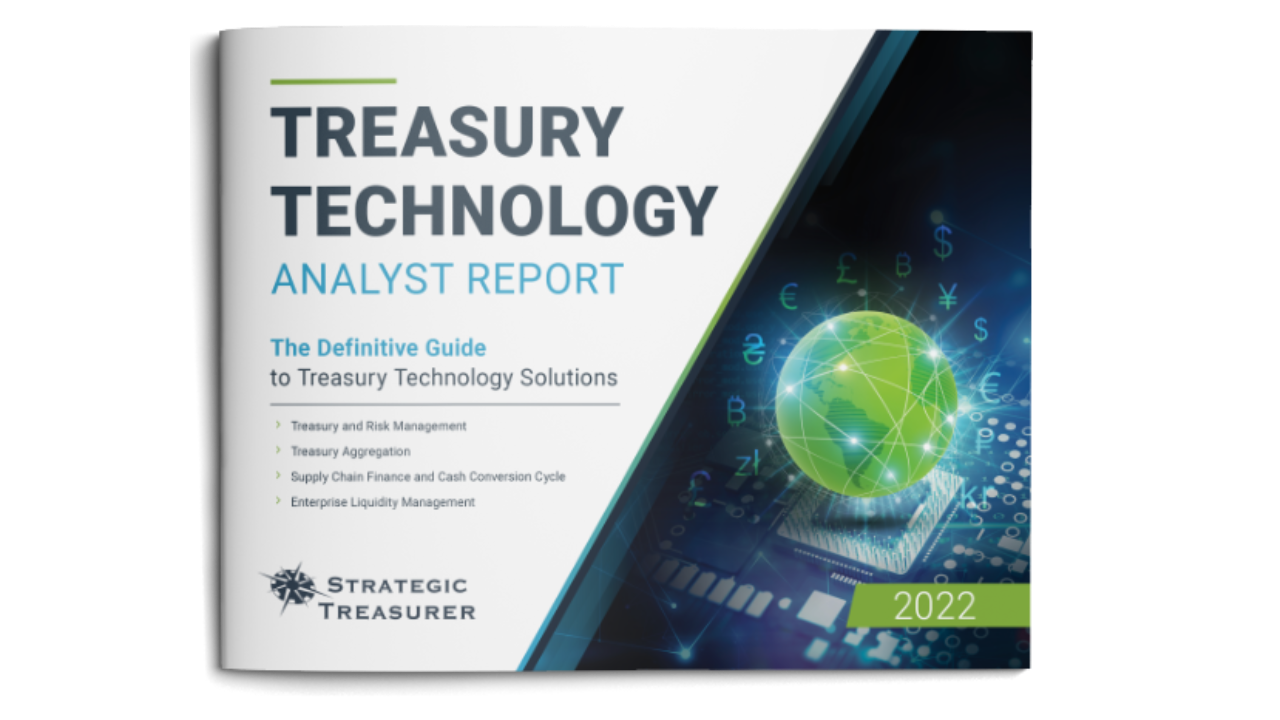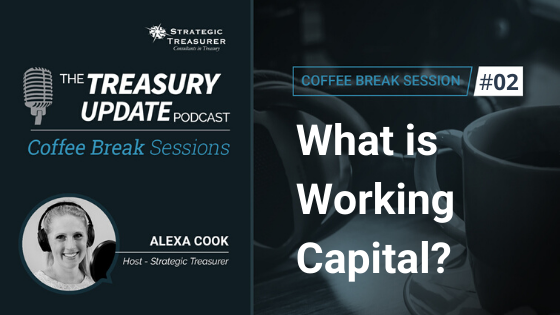
Episode 250
Working Capital: Thriving in Uncertain Times
Nobody wants to miss out on revenue growth. Until recently, it was relatively easy to borrow capital and increase inventory to avoid global supply chain issues, but things have changed. While you may have been able to accurately forecast demand, were you planning for the drastic rise in interest rates that have occurred in recent months? Is your working capital plan adjusting? In this episode, Craig Jeffery, Daniel Reeve, and Brian Rieber get together to discuss the macroeconomic, geopolitical, and trade situations surrounding working capital and the financial levers you should be aware of moving forward.
Host:
Craig Jeffery, Strategic Treasurer


Speaker:
Brian Rieber, LSQ


Speaker:
Daniel Reeve, Esker


Episode Transcription - Episode #250 - Working Capital: Thriving in Uncertain Times
Announcer 00:04
Welcome to the Treasury Update Podcast presented by Strategic Treasurer, your source for interesting treasury news, analysis, and insights in your car, at the gym, or wherever you decide to tune in.
Craig Jeffery 00:19
Welcome to the Treasury Update Podcast. This is Craig Jeffery. And today’s episode is called Working Capital, Thriving in Uncertain Times. I’m joined by Dan Reeve from Esker and Brian Rieber from LSQ. Welcome to the podcast, Dan and Brian.
Brian Rieber 00:35
Thank you, Craig.
Daniel Reeve 00:36
Thank you for having us. Yeah, thanks very much.
Craig Jeffery 00:39
Let’s jump in. We’ll we’ll get into your background in in a few moments. But let’s talk about the situation that companies are finding themselves in across a range of industries. And specifics. There’s a lot going on from a macro economic, geopolitical perspective. Just tell us what’s going on and calibrate that for us. And, Dan, if you’d start, and then I’ll look to you, Brian, to close out that topic.
Daniel Reeve 01:03
I was in Salt Lake last week, managed to combine some business with pleasure, a few days of great skiing, and I was that I thought we’re gonna see some customers and the trend across companies from the high tech space through to building materials and aggregate top companies. You know, once the three companies in the trend was similar, I think the financial leaders, they have said, Look, we need to control spend, we need to have better visibility of what we’re buying, we need to focus on a cautious approach, just in case approach. So that means not all of those companies. And before that was in prior companies have spoke to customers and spoke to have all said, Hey, there’s some kind of working capital focus, there’s working capital to capital initiatives of some sort. Or maybe we’ve been a bit a bit more careful about what we do is stock. Many cases, I think companies are having to have more stock because of supply chain disruptions. And therefore they have to have more stock so they can satisfy their customers. That’s expensive. And so I’m seeing across both receivables and procure to pay, we’ll see why I can’t really help companies with stock reasons, companies would turn to Esker because they’re trying to improve working capital either on what they do with receivables, or what they do with payables.
Craig Jeffery 02:18
So you’ve mentioned a couple things about controlling and managing working capital. Is this this just in cases that concerns about certain macroeconomic conditions? Inflation interest rates? What is driving that in their discussions?
Daniel Reeve 02:34
Yeah, you know, we did some research for TCU. Last year, Texas Christian, Christian University, and their new research institute and they were looking at what’s going on our company is sitting on more cash as working capital improved, and they saw a significant uptick in companies sitting on more cash. And is this trend from just in time to just in case and what that means is, companies are worried about inflation and the the impact of inflation. I think I’ve had companies say to me, everything is late all the time. Some of my customers have said that to me. And so I think the reality is, is it all down in whether you pin it on the you know, what’s going on in Ukraine and geopolitical issues? I’m not sure. But the reality is, I think most companies now are saying, Hey, we fully expect there to be supply chain issues. We are aware, we may need to have more stock at hand. And companies have increasingly really started to focus on what can we control here, receivables and payables. In maybe looking to see if you can take advantage of supply chain financing or working capital opportunities. That’s something folks can do. And I think the other thing that’s going on trend we didn’t talk about yet was freeing up staff to do the type of work they enjoy getting people out of manual work, because there’s a couple of things that you know, trends have continued there is folks want to do work, they enjoy the leave. It’s hard to onboard nucleoli, let alone find new staff. So you better find them the type of work that’s engaging. The Work provides value to your customers and suppliers, the work that’s of interest to them, or they’re not going to stay. And so retention and training of staff is another issue that I think finally the finance leaders supply chain leaders are having to deal with.
Craig Jeffery 04:21
Some really good points there. Dan. Brian, maybe can pick up the discussion as well. Back on the macroeconomic side, what are you hearing from that perspective, to add to Dan’s points?
Brian Rieber 04:32
I’ve heard exactly what Dan has heard from customers. And it doesn’t matter whether we’re skiing in Salt Lake or enjoying the beaches in Florida, that’s where LSQ is headquartered, or in Europe and Asia. It’s a consistent theme, but I would maybe take it a step further and say, What if some of those factors impacted in terms of actions? Right and what we’ve seen over the past two years are companies have increased that stock they tried to do their best at forecasting demand. And that’s proven to be largely impossible for many companies. So they not wanted to miss out on that revenue growth. They’ve increased inventory, they’ve allocated and borrowed capital to make sure that they could account for supply chain disruptions and delays. Well, the consequence of that over the last, you know, 10 years and exacerbated in the last two has been a significant amount of debt that’s been added to our clients balance sheets. And while they had difficulty forecasting their demand, none of them forecasted the rate with which interest rates will change. So you’d asked in terms of what that impact is, we see a lot of treasurers and CFOs, who, in a candid conversation would say they got caught off guard, right, it moved too fast. Now they’re playing defense and trying to figure out how to service the financial commitments and promises they made, in allocating more cost to just covering money than what was then. So these decisions and macro economic effects, the supply chain disruptions at geopolitical events, and the cost of money and the speed with which the cost of money has risen, are all related. And what that has really done is put some unprecedented constraints and challenges in front of our treasurers and CFOs. Today, that we’ve not seen in our generation.
Craig Jeffery 06:22
Let’s do a quick background and love for each of you to give a quick overview of your responsibilities. Brian, since you were most recently talking, why don’t you give your elevator pitch of what what you do at LSQ, a little bit about your background, then we’ll jump over to Dan.
Brian Rieber 06:41
My role at LSQ is the vice president of working capital solution. So I work with upper mid market to enterprise customers from a few 100 million to 20 billion it’s been in providing predominantly supply chain financing solutions and helping them optimize working capital more from a payables focus. You know, as a company, we have, we have a separate team who’s extremely experienced and focused on the AR side of the house. But as as a firm, this is what we do, we manage working capital for some of the biggest companies in the world and all of their suppliers.
Craig Jeffery 07:15
Great, and you’re located near the beaches in Florida. Okay. And over to over to you, Dan, just to just background.
Daniel Reeve 07:22
The title is Vice President of Sales for the Americas. And my job is to support the folks at Esker, who are providing solutions to predominately North American companies, but many global, as I said, have been here for over 25 years, Esker has been in business over over 35 years. And companies turn to Esker, so typically engage with finance leaders, supply chain leaders, customer service leaders, and companies tend to Esker when, as I said early, the expression I like to use is they’re trying to free up folks in the receivables or payables, credit or customer service departments to go and be rockstars. When what I mean by that is one, as I said, if you want to keep your staff use technology to free them up to go and do work that’s engaging, so they stay at your company. And perhaps they’re never able, instead of keying, keying, keying orders or invoices, they can deliver invoices to your customers faster, but the information that’s needed, they can chase up customers, you know, given smart insights as to who to chase and who can who can you chase and work with to get paid earlier? What can you do to automate and improve the match rate on your back end of your cash application process? What can you do on payables to ensure your suppliers get paid quickly, they’re happy. And you identify, hey, looks like this maverick spend over here looks like we could take better advantage of some sourcing opportunity over here and therefore reduce the cost we pay. So a lot of is about freeing up folks in in, as I said receivables, payables, customer service functions, effectively arming the CFO to have better visibility, make smarter decisions, control costs, optimized days payable, outstanding optimized, day sales outstanding and wow, customers effectively.
Craig Jeffery 09:13
We started on some macro economics and what what you’re hearing from customers. You mentioned the you know, there’s working capital initiative seems to be underway everywhere. I don’t know if you can give some examples without naming names or dive into some of those conversations a little bit more. You’ve touched on some. But are there other other things that would be helpful for our audience?
Daniel Reeve 09:37
Yeah, I think what I’ve seen over the last year or so is if we focus on the working capital side, and I’ve seen two things if I think about the receivable side, I’ve seen a lot of companies that are owned by equity groups, PE firms, etc. approach Esker because they’ve been instructed to improve their working capital. They’ve been instructed to improve age debt dependence. instructed to improve the balance sheet. So we’ve had a lot of interests, a lot of projects go ahead. Because of that focus from from the PE, the PE firms, the holding companies that own these companies. On the payable side, one of the things that’s been really interested in is going back to existing customers use Exker for procure to pay, and making them aware there is now an embedded finance option within the platform. And what that means in plain English is, sometimes the company will say, Hey, we’ve got plenty of cash, we’re in a really strong position, we can move the invoice around the organization, my term is at the speed of 1000 gazelles, because now they can reduce any delays, they can get the invoice encoded, approved really quickly, they can use use AI to, to help match, do three way match to automatically suggest the right coding so they can get the invoice in and around the organization far faster than ever before. Which means that now, if you’ve got cash in the bank, or you have access to a embedded finance provider, like LSQ, that’s weaved into the Esker platform. It means now that your your your suppliers, especially the treasury team, or the finance leaders over there, who are hungry, and hungrier than we’ve ever seen to get paid. They’re more likely to respond if you if you sort of put out some notes there to say, hey, we can pay you, you know, but we can pay you faster in return for a slight discount. Because we’re we’re seeing that companies are taking this mindset of yes, we want to extend terms or standardize terms. Yes, there’s opportunity here to possibly make this technology self-funding by earning more early payment discounts. Though there’s also this element of hey, I don’t want to lose my placing in the queue. There’s lots of disruptions, I cannot afford to move from third favorite customer to fourth favorite customer, for example. So I do want to make sure that we pay the suppliers quickly they can see when they’re gonna get paid. We make it easy for them to come online if need be and see, here’s what I’m, here’s what we’re going to pay you and any any any any deductions so that they are in a position themselves to go carry on buying goods and services from you. There’s some of the trends I’m seeing. And it’s been interesting. If we go back maybe a year and a half, two years ago, was there’s so much interest No, I really don’t think there was or people were talking about, hey, you can turn your finance team into a your payables team into a profit center will suddenly that is real based on the dramatic increase in the cost of borrowing. The food on the stove was sort of simmering now. No it’s burning, you know, now there’s, you know, you mentioned working capital, it seems to anybody in most companies, I’ll talk to you. So yeah, we have some kind of initiative. Yeah, that’s a focus. Yeah, there’s pressure from the top. You know.
Craig Jeffery 13:02
We’ve definitely seen that working capital supply chain financing very much came back in vogue with with a vengeance in the last six, nine months, maybe a little bit more. Yeah. Shifting over to, to LSQ. Brian, any other things that you’re hearing from customers that reflect on either the economy, the situation that we’re in?
Brian Rieber 13:23
Yeah, I think we can build off of what Dan said to what I’m hearing from customers is that over the last two years, three years, you know, maybe more there were two things happening, right? One, we had free money, it was relatively cheap. But two, they were all focused on the top line. Right. And, you know, one of the things that Dan was just saying, when we talked about inventory growth, what you didn’t hear two years ago was how do we cut costs. There’s more, how do we make sure we’re growing revenue? Everybody had a different mindset. Right? As soon as they realized it wasn’t the end of the world with the pandemic, and they could they could actually grow revenue. It was it was all in what we’re hearing today from customers across many, many industries is a few things. Number one, they have plenty of product to sell. Largely those supply chain delays, particularly in seasonal businesses, they missed their inventory shipments, right? You know, so if if your heavy sales were q4, and you tried to have things arrive in October, they arrived in December, it was a little late. And let’s say they’re sitting with excess inventory. So now they’re focused on how do we control costs? How do we make sure we exploit this to you know, keep our margins healthy in the current year without just consuming it on interest? And they’re starting to look at AP and AR specifically. What I would say is the mismatch between AP and AR. We have a lot of customers who are finding that their customer, their customers are also suppliers. And you know, they’re paying their customers bills in 30 days yet they’re not getting the AR side paid for 60 or 90 days because they were they were ahead of them. So there’s really a focus and say, Hey, wait a minute, let’s just at least make this equal so that we can, we can close an AP AR mismatch with the same person with the same with the same partner. We also see clients saying it’s time we start looking at data. And we’ve been growing revenue so much that the suppliers have often negotiated individual contracts, we’ve agreed to things to just get product in hand, I was working with a client earlier today, they’re in the retail business. And for the same supplier, they have seven different payment terms that range from net zero to net 90. And it’s the same supplier. It was crazy. They’re like, Okay, well, if we can just put this in the middle, we’d be in a better a better spot. So we’re starting to really see this conversations take place. So how can we leverage data? How can we work with our suppliers to make sure that we don’t, we don’t want to pass a burden off to them, they need to survive too. But we can work smarter, right, and we can control our costs and improve working capital for everybody so we all grow.
Craig Jeffery 15:55
You mentioned, you know, we’ve moved off of a period of free money, right, interest rates were almost at zero, certainly at the Fed level, and they’ve changed and shifted dramatically. You the other factor, too, is not everyone has access to capital at the same, the same level. Like larger firms, firms with higher credit ratings usually have access to quite a bit. That is not the same, you know, throughout the typical supplier economy. You know, I think, you know, Dan, you mentioned just in case a few times, right? Everything’s slower things like there’s just in case for inventory. But there’s also just in case for case for cash and liquidity that, that we have a little bit of a discussion on. So anything, anything else that you’re hearing in terms of, how do we protect our trading partners, if you’re talking to a large buyer, they’re trying to protect their suppliers, or they’re trying to they’re trying to manage working capital without breaking the other components in their ecosystem? Either of you have any comments on that, what you’re what you’re seeing or hearing?
Brian Rieber 17:02
Well, it’s definitely a theme that I hear more and more every single day. You know, for many years, we’ve heard this the affordable capital, right, but the access to capital is becoming very real, right? If we go back to 08 and 09, those of us that were around and working in this in the field, the challenge was a liquidity crisis because nobody had access to capital, right? The banks were sitting on these balance sheets, but they wouldn’t lend. And today, there’s a lot of capital out there, interest rates are rising, but what’s happening is things are flowing downhill. So your your higher investment grade, and even your higher end of non investment grade clients are getting access to capital, it’s become more expensive as to be expected. But you know, those that are on the lower end of investment grade or private, unrated companies are finding that the investors are happy with the yields that they can get with other companies that they feel are less risk, and they’re simply pulling back. So there’s less available, and that impacts a lot of suppliers, but in particular, a lot of DEI suppliers, we find so you know, there’s, there’s these competing initiatives of companies, and how do we manage the space? So I would say, Craig, there’s a huge challenge with access to affordable cash that exists today. In the mature banking world, we are seeing investors who do have the cash be a little more constrained about where they’re deploying it, you know, and instead of maybe pulling back a little bit, a lot of times, they’re just saying, we’re gonna go to zero and just pull the band aid off. But we’ve got other investments that we’re making. And that’s leaving a lot of people who have to respond quickly, who haven’t had the savings built up over over the past few years. So it’s, it’s a big concern, it’s going to be exacerbated, I think solutions like what we do in partnership with Esker on the AP in the AR side, it’s not surprising our phone is ringing significantly more frequently in the last few months, with these exact conversations
Craig Jeffery 19:02
Dan, any variants or additions to what Brian said?
Daniel Reeve 19:06
Yeah, I think one thing I’ve seen for the payables folks is that during the pandemic, many companies felt the need to diversify and have more suppliers in case there was a problem of one supplier. with that came a lot more work. So for many organizations, adding a supplier was a fair bit of work and would often either full on AP or full on procurement and obviously you need you need some socks controls in there to be in control who can onboard a supplier what I’ve seen is a couple of different things. One is okay, well we might want to have more supplies, but guess what, we’ve got to make sure that we’re not going to fall foul of any OFAC checks, you know, hey, these folks based in Russia if we need to know if we can deal with those guys, just as a crazy, you know, crazy example, but companies want to make sure that the okay we’re going to do more, extend our supplier As well, we better make sure these folks are good actors got the right bank details, we’re not going to fall foul of some bad bad actors here. So there’s, there’s due diligence needed, there’s process needed. There’s also I’m finding companies are saying, well, I need to ensure that the suppliers are trained, abide by a code of conduct. And that each six months or year, I’m both checking that they’ve been trained, they’ve got the right insurance, they’re going to represent us, they’re not going to embarrass our brand, you’re not there’s no child labor going on. Or, you know, we just need to be a bit more diligent and that will takes work. And so what I’m finding is companies are saying, hey, if anything, I need more supplies, I need to bring them on quicker. But I cannot sort of do away with the necessary controls to protect our brand or protect our company in our world. What that means is focusing, hey, if I need to have a supplier enablement, a supplier portal, that’s that’s easy for us to use speeds up the ability to bring on a supplier. And I’m not necessarily pushing all the work on the supplier, you know, it needs it needs to be good for for all of us. But we need to use some technology because we need to speed the process up without putting ourselves at risk.
Craig Jeffery 21:14
Yeah, very good. And last core section to talk about this topic of working capital, thriving in uncertain times. I want to talk about financial levers in addition to just reacting how do we how do we pull levers that free up capital or help our partners or support supply chain security? You know, this broad question of will your supply chain be ready? Is your financial situation strong enough? Or what do you need to do there? Brian, I want to start off with you and do some back and forth here. Between you about what what’s mattering here. In any section you’d like to start off with Brian.
Brian Rieber 21:52
Well, we should probably start off with with Accounts Payable since it’s near and dear to both Dan and I’s hearts and what our companies do, so.
Craig Jeffery 22:01
Should everybody have those seven different payment terms for a single single supplier.
Brian Rieber 22:08
It’s like why so few right, you know, Can you can you add ten more? Well, I would say is from an AP standpoint, I actually think AP is kind of the redheaded stepchild of working capital is amazing to me how many treasures I talked to, let’s say they focus on inventory. When they think of working capital, they focus on inventory, maybe they know their AR head of collections, and they they talked to them about what they could do to speed up payments, you know, they really don’t spend a lot of time on the AP side of the house. And I don’t know if that’s because they either don’t have the relationships or don’t see that lever. But, you know, if we look at the companies who are leading industry packs of working capital, you know, the industry benchmark for working capital, in almost every scenario, you see that Accounts Payable is best in class, right? Even if the others are older. So you know, when we think about a lever that’s often on tact for many companies, it’s coming out and engaging their supply chain counterparts, the head of AP, and really having a conversation using using data to figure out how they can impact this lever and have a pretty big impact on a on their working capital in a short period of time. Right. So for me, I clearly it’s a little self serving, but I will tell you, it’s I’ve been doing this for 20 years, and it’s amazing how many conversations I have where it’s like the first time we were having this conversation.
Daniel Reeve 23:35
What I read an article that said hey, tech, you know, a few articles I read said tech funding will go up. However, due diligence and scrutiny by CFOs will also go up. And many CFOs are worried about okay, well, this technology is there. But can you truly deploy technology that’s going to help us receivables and payables and supply chain financing that my teams are going to use, embrace, my suppliers are going to adopt? There’s metrics out there that are something like only 18% of digital transformation initiatives really work. So I think plenty of CFOs the can’t get the staff, the obviously under pressure to transition the role so staff stay, but at the same time that will help I’ll make sure this technology sticks and works and I get the return on investment. Because if I do it right when they put in transformations at work, what I’ve seen is that companies say wow, suddenly we believe we can do around here employees and you know various people want to get on board but when it when it doesn’t go well. Now, there’s you know, that’s problematic for the future. So some of the things I think they’re really important right now is if folks to your point in payables want to talk about, hey, we’ve got this technology, it can pay for itself. Yes, it can help the suppliers but we’re gonna have free up more working capital. They have to go armed with business cases. They have to go armed with business cases specific to their own data. For the CFO I find in many cases If he or she does say, Yes, I’m interested, yes or back this. They want to see, okay, show me how this is going to work, show me how many suppliers are already on your network or, you know, show me that you’ve done due diligence to prove this will work. And then I want to water that number down a little bit and be conservative. So I think the opportunity there is, yes, build relationships across, you know, with Treasury and finance. But you have to have any payables manager, procurement leader has to have data that’s based on their own data so that internally, the stakeholders will buy into it, versus versus another sales pitch, you know that I think that’s become even more important than ever, in the last year. And then everything I would say is, I’m seeing projects go ahead when finance leaders say, hey, so this technology can help us both in payables and receivables. And also on the cash application side, so I can pay my suppliers quicker, I can send my invoices quicker, more efficiently, chase that money, apply that cash, what we’re seeing is folks are buying into this idea of Best of suite, best of breed has been there for a while. But when folks realize, hang on a minute I can get I get benefits for various parts of my company, one one supplier that they have to deal with, you know, and I’m seeing more interest in that than I’ve ever seen. You know, finally I’m seeing payables folks and receivables folks actually collaborate and talk and share ideas and get together and say, well, this could benefit both of us. There’s been times when I haven’t been able to put my finger on why is it been? Why has it been so much interest in the last two years, but I’m definitely seeing folks buying into the idea of technology that can be beneficial for more than just one department.
Craig Jeffery 26:42
That’s interesting, you know, in terms of how you, you mentioned a couple of those items, you know, the the efficiency play has been probably number one for AP and AR for a long time. That’s their key focus Treasury’s, like, we need capital, we need to optimize capital, but they’re all part of the same cash conversion cycle. So you know, what you’re saying is now that the, you know, we’ve gone from 0% Fed, essentially 0% Fed funds rate to like 5%, in a very short period of time. Now it’s like, Okay, now what matters, the accessibility of capital, the willingness to get capital, put some pressure on there, and this, you know, this, this idea that having better visibility, allowing us not to say we’re going to pay in 45 days, because it takes us 45 days to approve items, means we can put our capital to play, we put third party capital to play. So it just gives it gives more people levers. It’s not just the lever that I pull, if I’m paying I pay later, I’ll go from 60 to 90 days, I pay later, everyone else suffers. There’s additional levers, and there’s some cost to that. But there’s some additional levers in play. I don’t know if I said that right, or if there’s anything else you wanted to add about financial levers, and maybe broadly supply chain security, right, your partners.
Brian Rieber 27:59
So a lot has been said on that. But I think what I would add is that AR relationship that Dan was talking about your point of the process efficiency, and you know, if you if we go talk to AP or AR they’re always focused on process and you know, efficiency as as a call center, right, I think it’s a mindset of what they’re doing. But what is not necessarily discussed in those individual units, is what the treasurer and the CFO cares about even more than the process efficiency is what’s what’s the cash costs, what’s the working capital impact? You know, these decisions, there’s a cause and effect of everything. So I think we’re finding people are more and more in tune to the fact of what are the unintended consequences is funny, I had a conversation with a PE on firm, that partner were there with a bank, they wanted to go to electronic payment methods. Well, they lost five days of flu, and all of a sudden, weren’t prepared for that as a highly leveraged company, because they stopped mailing checks. And in an interest rate environment that we’re seeing today, particularly as somebody levered, highly levered, that’s a material amount of money that, you know, they started consuming that they went, oh, boy, you know, the process became a lot more efficient, it was electronic, it was digital, it had all these checkboxes where they said, you know, had you considered when you went to an EFT as a payment method, for instance, maybe you standardize your payment terms at net 45 Instead of net 30, or net 60 Instead of net 45. And, you know, and you have it, you can have a good conversation of bridging that world of process and cost so that everybody makes out here, using that as a lever to gain adoption to make the technology transition easier both for our own organization and our partners that we’re paying, but also to make sure that we can create some advantages some cash advantages for the company as they make these transformations.
Craig Jeffery 29:50
Just wrapping this section up any comments about how should organizations think about making it easier for suppliers because it has to be beyond Just the conversation I’m sure you’ve had these this a we’ve got technology, there’s technology. There’s more to it than just that. What are some of the key things people should be thinking about?
Daniel Reeve 30:11
Yeah, I think in certainly we talked about creating a business case, use your data. But also think think about the outcome. So in six months, or 12 months, you put this technology and you put this new program in, ask yourself, How will success show up? How will we know that we’ve been successful? How will our suppliers know this has been successful? So I think it’s always valuable when you know, I’ll be honest, I encourage my reps to ask that question. Because then you often discover folks will will pause and think about that for a minute say, Okay, this is how we know, I guess this is how we would know the suppliers are using it, or this is how we know it’s the X amount of increase in working capital. So that’s a good question I encourage folks to think about is how will you and your stakeholders know it’s been successful in 6, 12, 18 months? The other thing for suppliers, I do think it’s a case of just because you build it doesn’t mean you’ll come. I’ve had one recently one CFO, describe his suppliers, his ankle biters, they’re desperate to know when they’re going to get paid. And that can often take up 20 to 25 30% of the time of the AP staff just answering phone calls and emails. When you’re going to pay us? What are you going to pay? Which invoices you’re going to pay off I think their AR teams, their cash application teams need that information. You can put that information into a portal and make it readily available self and allow them to self serve, which frees your staff up to go and do more valuable things. But I think the other thing, which which is key LSQ is great at this. You can enable the technology to so you can you can have the technology to receive invoices, be able to pay those invoices really fast, faster, faster, and, you know, at a rate that’s attractive to the Treasury team at the supplier. But you’ve got to make it easy for the supplier to say, oh, there’s a new tool, I’ve got to use a new tool to go online, you know, see my payments or accept early payments, or this is key where I think yes, you as the enterprise can be can be sort of encouraging the supplier, selling it to them, making them understand that what’s what the change is. But also I think you need a team to team up with someone. And in this case, I’ll say LSQ, they do a lot that if not most of the heavy lifting. And that’s important, because it’s not just about technology. I mean, I’ve got a project right now going on in Colorado, where that’s the that was the key concern for the finance and the leadership team was all well, we’ve got to get to learn to use this new tool, and so have our suppliers. So I think you really want to do your due diligence to make sure that whoever you team up with, get in the trench and work with you to talk and educate and woo the suppliers to come and use the platform.
Craig Jeffery 30:31
Thank you both. I just wanted to give you both an opportunity for any any final thoughts or comments, anything to leave in emphasis? I’ll start with you, Brian. And then finish with you, Dan.
Brian Rieber 32:58
I think this is top of mind for me, because we just closed first quarter, right? Finance teams are wrapping up q1 financials, we’ll see what the what this looks like in the next few weeks for the corporate world. But I want to say I’ve had a lot of conversations, as Dan said, every client, every company has a working capital initiative out right now. And the thought that’s in my head incessantly is a ticking clock. Do not run out of runway. It is for corporations trying to have a working capital impact and 2023, your job is never easier than it is today. And what I mean by that is at the end of the day have to move spend or receivables in one way or the other. And you have the advantage of the next nine months to have the results of those decisions you make today. But if you wait even one more quarter, you’re moving literally twice as much money, you have twice as much to lift in order to have an impact by December 31. It is a critical thing that we don’t necessarily think about the impact of time. When we think about working capital, we focus on the dollars and whatnot. But the value of time here is the arguably the most important factor to making your life easier. And you know, taking taking efforts today, whatever you’re going to do is going to have the best impact and at the end of the year when you fill out your your results.
Craig Jeffery 34:21
Thanks for those comments. And Dan, any final thoughts?
Daniel Reeve 34:25
Sometimes when folks think about this, they might be worried about What is the time and the effort to set it up? Because most companies have some kind of ERP upgrade or transformation going on, their IT teams are really, really busy. And I think for many when you think about this is like Okay, so this is we’re talking about working capital. But we’re also at some point you’re going to have to engage with the folks in IT to understand Is this going to be a fit for us? Is it going to work for us? How long is this going to take? So I think we shouldn’t forget that folks in IT need to be part of the conversation and they may be surprised once they take a look closer that it doesn’t have to be as long and complicated as they might assume.
Craig Jeffery 35:07
Excellent. Dan and Brian, thank you so much. We appreciate appreciate your time.
Announcer 35:16
You’ve reached the end of another episode of the Treasury Update Podcast. Be sure to follow Strategic Treasurer on LinkedIn. Just search for Strategic Treasurer. This podcast is provided for informational purposes only, and statements made by Strategic Treasurer LLC on this podcasts are not intended as legal, business, consulting, or tax advice. For more information, visit and bookmark StrategicTreasurer.com.
Subscribe to the Treasury Update Podcast on your favorite app!
Related Resources
Treasury Technology Analyst Report
Researching new treasury and finance technology can be overwhelming. Strategic Treasurer has stepped in to help. Explore our definitive guide to the treasury technology landscape and discover detailed, data-based coverage.








